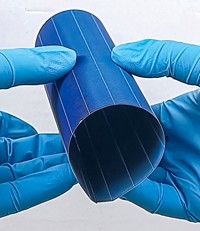Advertisement
Grab your lab coat. Let's get started
Welcome!
Welcome!
Create an account below to get 6 C&EN articles per month, receive newsletters and more - all free.
It seems this is your first time logging in online. Please enter the following information to continue.
As an ACS member you automatically get access to this site. All we need is few more details to create your reading experience.
Not you? Sign in with a different account.
Not you? Sign in with a different account.
ERROR 1
ERROR 1
ERROR 2
ERROR 2
ERROR 2
ERROR 2
ERROR 2
Password and Confirm password must match.
If you have an ACS member number, please enter it here so we can link this account to your membership. (optional)
ERROR 2
ACS values your privacy. By submitting your information, you are gaining access to C&EN and subscribing to our weekly newsletter. We use the information you provide to make your reading experience better, and we will never sell your data to third party members.
Materials
Solar Cells From Inexpensive, Low-Grade Silicon
Materials: Nanostructured ribbons of silicon absorb light with high efficiency
by Prachi Patel
September 11, 2012
CORRECTION: This story was updated on Sept. 13, 2012, to reflect that thin-film solar cells other than those made from amorphous silicon are on the market.
Researchers have made flexible solar cells by carving light-trapping nanostructures into thin strips of low-grade silicon (Nano Lett., DOI: 10.1021/nl3020445). Because the cells use tiny quantities of inexpensive, low-quality silicon, they should cost much less than rigid crystalline silicon cells on the market, says Akram Boukai, a materials science and engineering professor at the University of Michigan, Ann Arbor. Scientists would like to develop such low-cost, lightweight, bendable solar cells for use on vehicle surfaces and even on cloth.

To make solar cells, manufacturers perform costly processing of raw crystalline silicon to make it more than 99.9999% pure. Without the purification step, impurities in raw silicon would trap electrons and holes, the positions in the material missing an electron. As a result, the impurities form barriers to electric current and reduce cell efficiency.
Boukai, Anish Tuteja, and colleagues wanted to cut the cost of solar cells so they decided to use metallurgical-grade polycrystalline silicon that is 99.999% pure. The material costs $10 per kilogram, making it at most one-fifth the cost of solar-grade silicon.
The researchers worked around the issue of impurities in lower-grade silicon by keeping short the distance that electrons and holes travel, allowing them to encounter few impurities in their transit. To do so, they first cut a 17-µm-thick sheet of the silicon into thin ribbons, less than a millimeter in width.
To make flexible cells, the researchers deposited hundreds of parallel silicon ribbons on a bendable plastic substrate. They coated the ribbons with a block copolymer that assembles into an array of upright hollow cylinders, each 34 nm in diameter. Next they deposited a 30-nm-thick layer of silver, which enters each tube. They removed the polymer with a toluene wash, leaving behind an array of silver nanoparticles molded by the cylinders. Finally, they used reactive ion etching to remove silicon. The silver particles protect the silicon underlying them, so the etching produces an array of tiny silicon pillars topped with silver nanoparticles.
The silver particles absorb and channels light into the underlying pillars. The forest of pillars, meanwhile, traps light: light waves bounce both inside and between them, giving the material more time to absorb it. The nanostructured material absorbs 95% of the light falling on it, compared to unstructured bulk silicon, high- or low-grade, which soaks up 60%, Boukai says. The more light a photovoltaic material absorbs, he adds, the more current it can produce, increasing its efficiency.
The cells convert light to electricity with close to 10% efficiency. This is less than that of high-grade crystalline silicon, at 15 to 17%, but higher than the 8% efficiency of solar cells made from amorphous silicon, which are among the few thin-film cells on the market. The researchers have already found ways to further increase the new cells’ efficiency, Boukai says.
The Michigan team’s cells are not the first thin, nanostructured solar cells, says Erik Garnett, a nanoscale solar researcher at the Foundation for Fundamental Research on Matter (FOM) Institute for Atomic & Molecular Physics, in Amsterdam. However, in an “exciting step,” he adds, the cells are the first that use low-grade silicon to convert light to power with “reasonable” efficiency. “This innovation could help reduce the price of silicon solar cells,” he says
“The efficiency is pretty impressive,” says L. Jay Guo, an electrical engineering and computer science professor at Michigan, who was not involved in the research. However, he adds, the nanopatterning and etching steps could make large-scale manufacturing a challenge.





Join the conversation
Contact the reporter
Submit a Letter to the Editor for publication
Engage with us on Twitter